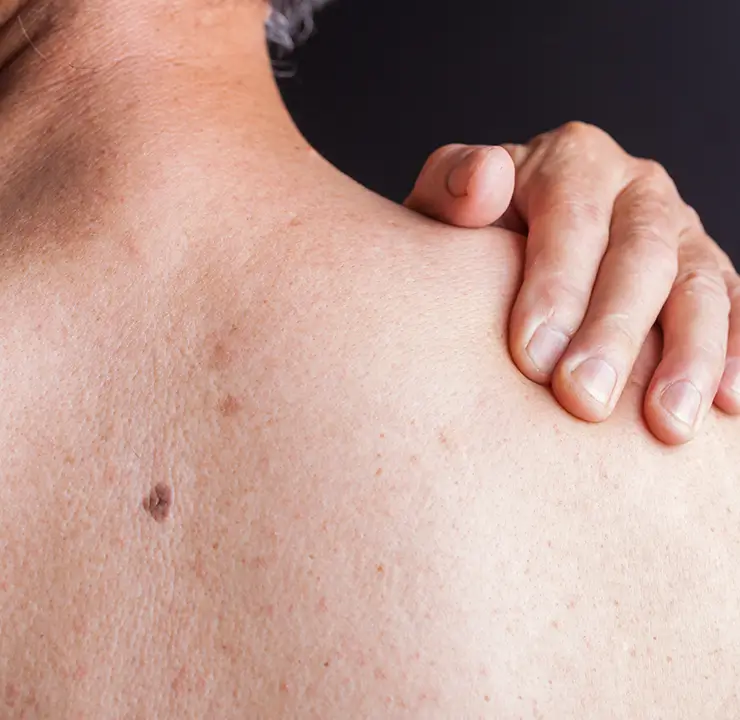
Melanoma
Learn about early detection, personalized care and leading-edge treatments with UCI Health melanoma services.
At UCI Health, our nationally recognized physicians are experts in diagnosing and treating melanoma and all skin cancers.
Signs and symptoms of melanoma
Most of us have between 10 and 30 moles on our skin before the age of 50, and most are benign.
But when new moles appear or existing moles change in size or shape, use the A-B-C-D-E cancer-warning guide:
- A is for asymmetrical. One side of a mole is shaped or sized differently than the other.
- B is for borders. If the borders of a mole are irregular, jagged or rough, it can indicate cancer.
- C is for color. If the mole is an unusual color or has multiple colors within it, it should be checked by a physician.
- D is for diameter. Moles that are larger than a pencil eraser should be evaluated.
- E is for evolving. Moles that are evolving or changing in color, size, shape, sensation or even bleeding, should be examined by a doctor.
Other suspicious changes in a mole may include:
- Scaliness
- Itching
- Spreading of pigment from the mole into the surrounding skin
- Oozing or bleeding
We recommend checking your entire body every three to four months for moles or patches that exhibit these warning signs. You should also have a yearly skin exam by a trained dermatologist.
Related conditions
In addition to melanoma, we treat all types of skin cancers, including:
- Basal Cell Carcinoma (BCC) is the most common skin cancer, making up about 75% of cases in the U.S. While it’s rarely life-threatening, it can cause noticeable changes to your skin if left untreated.
- Squamous cell carcinoma (SCC) is the second most common skin cancer. It often shows up as a firm red bump, an unusual patch or a sore that bleeds and doesn’t heal.
- Spindle cell carcinoma is a specific type of SCC that features spindle-shaped cells. It usually appears as a firm, raised lump and can be aggressive, so it’s important to get it checked quickly.
- Merkel cell carcinoma is a rare cancer that forms on or just below the skin's surface, often in sun-exposed areas.
- Sarcoma of the skin is another rare cancer that starts in connective tissues like fat or muscle. It can look like lumps or sores and may need specialized treatment.
- Cutaneous T-cell lymphoma is a skin lymphoma that shows up as rashes, patches or lumps. It can be long-lasting and usually requires special management.
Diagnosis and staging melanoma at UCI Health
UCI Health specialists use the most advanced technology and latest techniques to diagnose melanoma, including:
Melanoma treatment at UCI Health
We treat many types of melanoma, including:
- Superficial spreading melanoma
- Nodular melanoma
- Lentigo maligna melanoma
- Acral lentiginous melanoma
- Desmoplastic melanoma
Our team of melanoma specialists work together to develop a treatment plan tailored to your needs. Individual treatment plans are based on:
- Type of skin cancer
- Location and size of the cancer
- Microscopic growth patterns of the cancer cells
- Your age and overall health
- Your comfort and convenience
Why choose UCI Health for melanoma care?
NCI Designated
Our specialists are part of the Chao Family Comprehensive Cancer Center, Orange County's only National Cancer Institute-designated comprehensive cancer center and one of only 57 such facilities in the nation. This puts us at the forefront of research efforts to find new methods to treat and prevent melanoma.
A multidisciplinary approach
Our multidisciplinary team includes dermatologists, surgical oncologists, medical oncologists, oncodermatologist, radiation oncologists, plastic surgeons, clinical pharmacists, nurse navigators, case managers and other healthcare professionals. Together, we work with you to develop a personalized treatment plan in a caring and healing environment.
Clinical trials
At UCI Health, you have access to a wide range of treatment options, including NCI-sponsored clinical trials and our own proprietary skin cancer trials. This dual approach allows us to offer leading-edge therapies and personalized care tailored to your needs. By participating in these trials, you can benefit from the latest advancements in melanoma treatment while contributing to important research that may improve outcomes for future patients.
Tumor board
Our tumor board meets twice a month to discuss and review complex melanoma cases. Our dermatopathologists play an important role in this process, providing their specialized knowledge in analyzing skin samples, which helps guide treatment decisions. This teamwork helps us create personalized treatment plans, ensuring you receive the most effective care tailored to your needs.

Take control of your skin health
Schedule a consultation today for expert melanoma care and early detection.
Call 949-824-0606 to make an appointment.

Find a cancer clinical trial
Talk to your doctor to see if a cancer clinical trial is right for you.

Richard A. Van Etten, MD, PhD, Director — UCI Health Chao Family Comprehensive Cancer Center
“Our mission is to translate the findings of our research into treatments that can benefit patients, driven by a strong commitment to scientific discovery and clinical innovation.”
Featured Blog Posts

A 'dream come true' realized in Irvine
Dr. Michael J. Stamos once envisioned opening a small cancer center on the UC Irvine campus. What has emerged, he says, is so much more.

Devoted donors pay it forward

Reimagining cancer care for all of Orange County
When it opens July 16, the Chao Family Comprehensive Cancer Center’s newest location will offer superior care, comfort and convenience.




